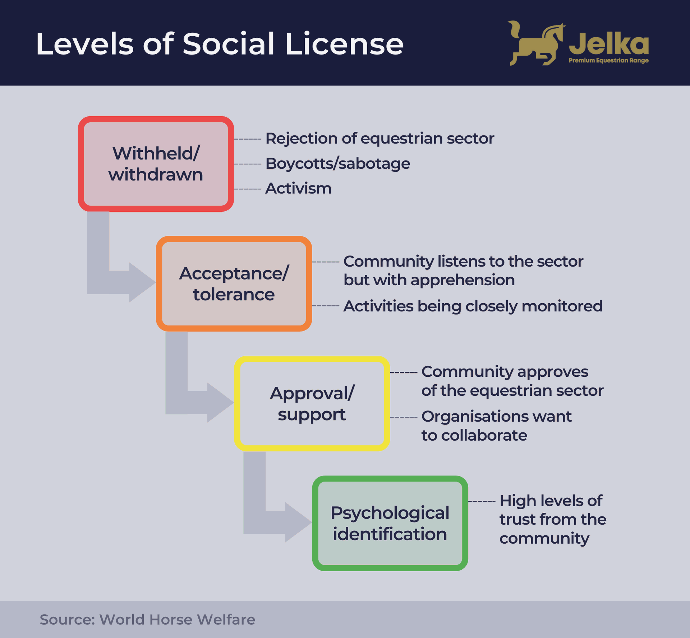What is a ‘social licence to operate’ in the equine industry?
A sport’s ‘social licence to operate’ refers to the general public’s overall perception of the sport in question. It is an unwritten contract in which society gives a sport the ‘right to operate’, as the overall perception is positive or neutral. Without a positive public perception, the sport’s future is at risk.
Levels of Social License

Sports regarded positively by the public are trusted within the community and organisations are happy to collaborate with the sport. Sports at the other end of the scale are rejected by the community, leading to boycotting, activism and eventual bans.
It’s thought that equestrianism sits somewhere in the middle. It is accepted with trepidation, and negative media is already evident in most branches of the sport. Recent research by YouGov showed that 40% of interview respondents would only support the use of horses with improved welfare, with 20% not supporting the use of horses in sport at all.
The introduction of camera phones, hidden cameras and social media means that activities which once went on behind closed doors are now visible for the public to see. While this is a positive step when it comes to improving equine welfare, it has almost certainly led to a more negative public perception of the industry.
What are the welfare issues facing equines?
If we’re talking solely about public perception, the issues that pose the greatest risk to the future of our sport are those that are brought to the public’s attention via activists (for example, the huntswoman who was filmed by the Hertfordshire Hunt Saboteurs kicking and punching a pony), or those that enter mainstream media (the poor riding during the show jumping phase of the Tokyo Olympics’ modern pentathlon).
But in a paper titled ‘Social Licence to Operate: What Can Equestrian Sports Learn from Other Industries?’, Janet Douglas writes that these issues are just the ‘tip of the iceberg’, and that issues which are yet to enter mainstream public awareness have a greater impact on a horse’s quality of life, including the ‘approximately 23 h/day for which many horses are stabled’.
Further studies have suggested that the biggest issue facing our equine friends is the problematic but often normalised management practice of stabling 24 hours a day, and it’s only a matter of time before this is brought to the public’s attention.
For the average equine, a lack of turnout is the biggest risk to their health and happiness, and countless studies have corroborated this. Our management of horses has changed over the years, but a horse’s basic needs have remained unchanged. Horses are herd animals, requiring full contact with other equines and as much turnout time as possible. A lack of turnout can lead to stress-related behaviours, as well as respiratory, digestive and locomotive problems.
Improvements within the industry
Improvements are being made when it comes to equine welfare. In 2020, British Showjumping introduced a new padded whip rule, following British Racing which made the change in 2004. Elastic hind boots have recently been banned in young horse classes, and while the misuse of spurs is an offence, an additional British Showjumping rule states that ‘riders must take care that the manner in which they use their spurs does not offend the public’.
But although more stringent regulations have been put in place when it comes to competing and training, there are very few management regulations in place. Lack of turnout and social isolation still remain a very real threat to the welfare of our equines.
Big names within the industry are starting to recognise their responsibility in leading by example. Carl Hester right or wrongly made industry headlines for saying that he turns his horses out in the field year-round. While horse welfare advocates and experts would consider year-round turnout as being the bare minimum when it comes to equine health and happiness, this is clearly not the case across the board, evidenced by the widespread surprise of this revelation.
It is clear that there are a number of pieces to the puzzle, and work is needed across every discipline. Despite improvements being made, it is the responsibility of every member of the community to improve both the public’s perception of equestrianism, and the welfare of our horses.